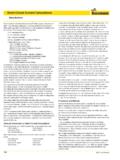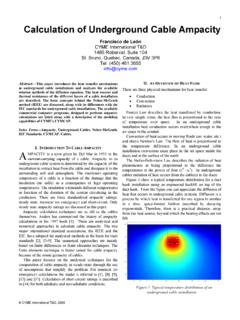Transcription of SKM Power*Tools For Windows Software Training …
1 SKM Power*Tools For Windows Software Training Course101 PTW Software Standard 3-Day TrainingDAPPER, CAPTOR, A_FAULT, and TMS101 PTW Software Standard 3-Day TrainingObjectivesTo develop a working knowledge of the Power*Tools for WindowsDAPPER, CAPTOR, A_FAULT, TMS, and Equipment Evaluationsoftware study modulesDatabase Concepts, Default Data, Copy/Paste Data, Clone ComponentsOne-Line Diagrams, Copy/Paste, Annotation, Custom Symbols, Hideand Expand, UNDO, and Template LibrariesCreation, customization and use of Datablocks and Datablock ReportsManaging multiple scenarios with Scenario Managerand Data VisualizerEfficient management and use of Equipment LibrariesReporting Options and Customized Output FormsImport/Export CapabilitiesMerging Multiple Projects and Multi-user AccessCustom Queries and User-Defined FieldsPrerequisitesBasic computer are urged to review: IEEE Red Book Std 141-1993, chapter 4 IEEE Buff Book Std 242-2001, chapters 9, 10 & 11 IEEE Brown Book Std 399-1997, chapters 2, 6, 7, 9 & 15 course DescriptionThe course involves the discussion of the program interface.
2 Managementof multiple scenarios with scenario manager is covered. Demand Load,sizing, load flow, short circuit , load schedules, captor and motor startingcalculation procedures are then reviewed. Other topics that will becovered are the efficient management and use of equipment libraries,reporting options and customized output forms, import/exportcapabilities, merging multiple projects, as well as custom queries anduser-defined fields. Students will earn CEUs for this Section (Torrance, CA only)Introduction and demonstration to I*SIM (Transient Stability Analysis)and Hi_Wave (Harmonic Analysis).Target AudienceThis course is intended for electrical power engineers responsible for thedesign and analysis of three phase electrical distribution previous electrical distribution system analysis experience is LoadConnected, Demand, and Design Load Analysis for SizingDemand Load LibraryInput Data RequirementsOutput Report OverviewSizingFeeder and Transformer Sizing CalculationsCable and Transformer LibrariesInput Data RequirementsOutput Report OverviewLoad SchedulePanel, MCC and Switchboard Schedule RepresentationInput Data RequirementsOutput Report OverviewLoad Flow StudiesSolution TechniquesSources of Supply RepresentationTransformer, Load and other Component RepresentationVoltage Drop Snapshot of Motor StartupInput Data RequirementsOutput Report OverviewFault StudiesSolution Techniques.
3 Comprehensive Fault Analysis, ANSI Fault AnalysisComparison of Methodologies between Comprehensive and ANSIC ontribution Sources RepresentationsInput Data RequirementsOutput Report OverviewMotor Starting StudiesSolution MethodologyMotor ModelsLoad ModelsSoft Starter and Reduced Voltage Starting ModelsInput Data RequirementsOutput Text and Graphical Data OverviewCaptorCreation of Time-Current Curves from New and Existing ProjectsCustomization of TCC Drawing Layouts and LibrariesUsing Forms to Print TCC DrawingsExport of TCC Drawing to Third Party ApplicationInput Data RequirementsTCC Settings ReportSelective CoordinationDatesJanuary 19, 20, 21 (Torrance, CA)March 16, 17, 18 (Detroit, MI)April 6, 7, 8 (Torrance, CA)June 8, 9, 10 (Cleveland, OH)August 3, 4, 5 (Torrance, CA)September 28, 29, 30 (Houston, TX)November 9, 10, 11 (Torrance, CA)Hours7:30 AM to 5:00 PM, Monday through WednesdayFees$1,025 for 101 Standard, 3-Day$1,755 for 101 and 102, 5-DayDoes not include hotel or travel Training ManualContinental breakfast each morning at 7 am and on-site lunchIEEE IACET Certificate of Completion (CEU)Torrance, CA only: Use of one computer per two studentsGroup dinner on Monday following the classEquipmentStudents not attending the Torrance, CA classes are responsiblefor bringing their own laptop computers.
4 SKM will provide the latestversion of the PTW Software two weeks prior to the class forinstallation with a Software key. The Torrance, CA Training room isequipped with Dell computers with Pentium-4 or betterprocessors, 512MB RAM, and 17 LCD flat panel class size is based on 2 students per Torrance DoubleTree Hotel at South Bay address is 21333 Hawthorne Blvd. Torrance, CA 90503 and is located 10 milesSouth of Los Angeles International Airport (LAX). Airporttransportation is approximately $30 for a taxi or $15 forSuperShuttle. The hotel is also conveniently located miles eastof the beach and the Redondo Pier. Restaurants and shops arewithin walking distance from the hotel. Parking and wirelessinternet usage at the hotel is reservations call 1-800-445-8667 and be sure to ask for theSKM corporate rate of $139 per Power*Tools For Windows Software Training CourseObjectivesTo develop a working knowledge of the Power*Tools for WindowsArc Flash and Equipment Evaluation Software study modulesTo understand the Arc Flash standards and calculation methodsTo obtain hands-on experience in Arc Flash Label creationand customizationTo understand the step by step evaluations process and criteria forprotective and non-protective devicesArc Flash analysis of several hands on examples of electrical distributionand systems utilizing the PTW softwareInterpretation of PTW Arc Flash results and study optionsReview issues related to energy accumulation and multiplecontributions and its effects on Arc FlashTo
5 Understand the step by step evaluation process and criteria forprotective and non-protective devicesPrerequisitesBasic computer skillsPTW 101 or equivalentStudents are urged to review: IEEE Red Book Std 141-1993, chapter 4 IEEE Buff Book Std 242-2001, chapters 9, 10 & 11 IEEE Brown Book Std 399-1997, chapters 2, 7 & 15 IEEE 1584 2002/2004a, Guide for Performing Arc FlashHazard Analysis NFPA 70E-2004 Standard for Electrical Safety in the WorkplaceCourse DescriptionThe course covers the overview of the Arc Flash standards and reviews thecalculation and modeling procedures in Arc Flash and EquipmentEvaluation. Students will earn CEUs for this Section (Torrance, CA only)Introduction and demonstration to Ground Mat (Ground Grid Design andAnalysis) or Distribution Software Advanced 2-Day TrainingArc Flash and Equipment Evaluation102 PTW Software Advanced 2-Day TrainingDatesJanuary 22, 23 (Torrance, CA)March 19, 20 (Detroit, MI)April 9, 10 (Torrance, CA)June 11, 12 (Cleveland, OH)August 6, 7 (Torrance, CA)October 1, 2 (Houston, TX)November 12, 13 (Torrance, CA)Hours 7:30 AM to 5:00 PM, Thursday and FridayFees$825 for 102 Advanced, 2-Day$1,755 for 101 and 102, 5-DayDoes not include hotel or travel Training ManualContinental breakfast each morning at 7 am and on-site lunchIEEE IACET Certificate of Completion (CEU)Torrance, CA only.
6 Use of one computer per two studentsGroup dinner on Monday following the classEquipmentStudents not attending the Torrance, CA classes are responsiblefor bringing their own laptop computers. SKM will provide the latestversion of the PTW Software two weeks prior to the class forinstallation with a Software key. The Torrance, CA Training room isequipped with Dell computers with Pentium-4 or betterprocessors, 512MB RAM, and 17 LCD flat panel class size is based on 2 students per Torrance DoubleTree Hotel at South Bay address is 21333 Hawthorne Blvd. Torrance, CA 90503 and is located 10 milesSouth of Los Angeles International Airport (LAX). Airporttransportation is approximately $30 for a taxi or $15 forSuperShuttle. The hotel is also conveniently located miles eastof the beach and the Redondo Pier. Restaurants and shops arewithin walking distance from the hotel.
7 Parking and wirelessinternet usage at the hotel is reservations call 1-800-445-8667 and be sure to ask for theSKM corporate rate of $139 per Flash Hazard AnalysisUnderstanding Arc Flash Hazards: Shock, Burns, Blast Pressure,Shrapnel and HeatOverview and background of IEEE 1584 and NFPA 70E standards - Existingand Proposed standardsSelection of correct Personal Protection Equipment to protect workersNEC Article and OSHA Electrical Safety Program requirementsDevelop safe work practices and proceduresArc Flash Labeling and Work Permit Requirements with hands-on examplesHazard Risk CategoriesDiscussion of Arc Flash boundaries and limits of approach - Limited,Restricted, and ProhibitedUnderstanding IEEE 1584 and NFPA 70E Calculation ProceduresArc Flash analysis of several hands on examples of electrical distributionsystems utilizing the PTW softwareInterpretation of PTW Arc Flash results and study optionsReview issues related to energy accumulation and multiple contributionsand its effects on Arc FlashReview issues related to Induction Motor and Generator decays and itseffects on Arc FlashReview issues related to protective device line side and load sideArc Flash calculationsHands-on example of applying various techniques to reduce arc flashhazards to below 40 cal/cm2 Equipment EvaluationRelationship with short circuit , and Equipment SizingInput Data requirements, Interrupting Rating, Close-Latch Rating, andTest X/RLow voltage device evaluation based on ANSI.
8 IEC and ComprehensiveFault resultsHV/MV device evaluation based on ANSI, IEC and ComprehensiveFault resultsEvaluation using bus fault current or worse case current through the deviceEvaluation Criteria Pass, Fail, or MarginalInterpretation of PTW Equipment Evaluation resultsTarget AudienceThis course is intended for electrical power engineers responsible for thedesign and analysis of three phase electrical distribution systems. Noprevious electrical distribution system analysis experience is Power*Tools For Windows Software Training Course203 Advanced Power Systems Application TrainingShort circuit , Equipment Evaluation, Protection & Coordination, and Arc Flash EvaluationObjectivesReview of distribution system analysis topics, including short - circuit ,equipment evaluation, protective device coordination, space and arcflash hazard analysisReview of fundamental considerations for protection, including datagathering, fault calculations, equipment damage and safetyAnalysis of a sample electrical distribution system using thePTW softwareDiscussion of short - circuit , equipment evaluation, overcurrentcoordination.
9 And arc flash hazard analysis resultsPresent methods used to reduce the arc flash hazardDiscuss compliance with various codes and standards including ANSI,NEMA, NEC and CECP resentation of several class examples that will help students gain abasic understanding of how to select and apply conductors, fuses, lowand medium voltage circuit breakers, overcurrent relays andcurrent transformersProvide practical examples of analysis from typical Industrial andCommercial power systems with explanations of study results and howthey are presented in a final reportDiscuss issues and examine study results, potential problem areasand implementation of study recommendationsPrerequisitesBasic computer skillsSKM Power*Tools Standard 3-Day and Advanced 2-Day Training , ORworking knowledge of SKM PTW class is not recommended for are urged to review: IEEE Red Book Std 141-1993, chapter 4 IEEE Buff Book Std 242-2001, chapters 9, 10, & 11 IEEE 1584 2002/2004a, Guide for Performing Arc FlashHazard Analysis NFPA 70E-2004 Standard for Electrical Safety in the WorkplaceCourse DescriptionThe course involves the application of the Power*Tools program to analyzea sample electrical distribution system.
10 short - circuit , protective devicecoordination, equipment evaluation and arc flash hazard analysis will bereviewed and then performed using the Software . Students will earn for this Systems Application TrainingTarget AudienceThis course is intended for electric power engineers responsible for thedesign, analysis, and maintenance of three-phase industrial orinstitutional power distribution systems. A basic understanding ofelectrical distribution system analysis is Industrial and Commercial Power System ExampleReview of distribution system analysis topics including short - circuit ,protection of apparatus, protective device coordination, equipmentevaluation, and arc flash hazard analysisDiscussion of compliance with various standards and requirementsData gathering and input data requirementDiscussion of considerations when selecting equipmentOutput data requirementExamination and interpretation of PTW study results andpotential problem areas in the power systemDiscussion of equipment evaluation and coordination study resultsDiscussion of methods and procedures on completing a typical studyDiscussion of arc flash hazard analysis results and methods used to reducethe hazard to below 40 cal/cm2 Discussion of final pres






